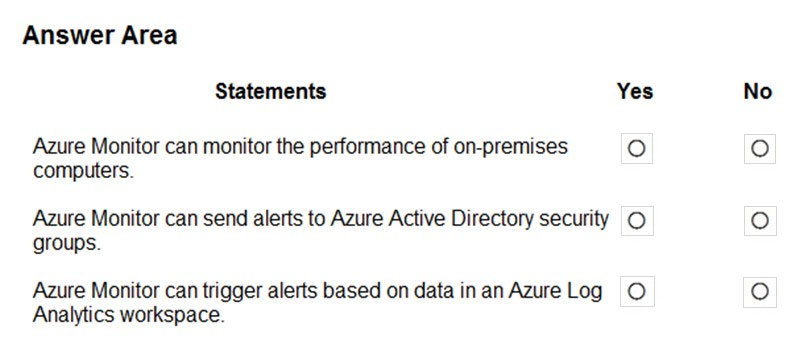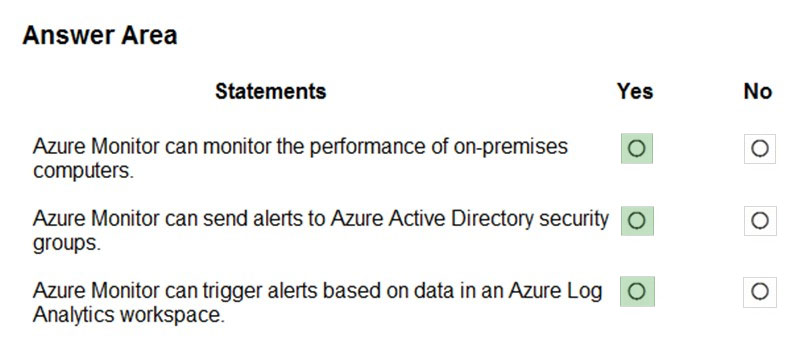HOTSPOT -
For each of the following statements, select Yes if the statement is true. Otherwise, select No.
NOTE: Each correct selection is worth one point.
Hot Area:
Answer:

Box 1: No -
Easily manage your Azure storage accounts in the cloud, from Windows, macOS, or Linux, using Azure Storage Explorer.
Box 2: Yes -
Azure cloud services can be managed in Azure Automation by using the PowerShell cmdlets that are available in the Azure PowerShell tools.
Box 3: Yes -
Reference:
https://azure.microsoft.com/en-us/features/storage-explorer/
https://docs.microsoft.com/en-us/azure/cloud-services/automation-manage-cloud-services
HOTSPOT -
To complete the sentence, select the appropriate option in the answer area.
Hot Area:
Answer:

Azure Databricks is an Apache Spark-based analytics platform. The platform consists of several components including 'MLib'. Mlib is a Machine Learning library consisting of common learning algorithms and utilities, including classification, regression, clustering, collaborative filtering, dimensionality reduction, as well as underlying optimization primitives.
Reference:
https://docs.microsoft.com/en-us/azure/azure-databricks/what-is-azure-databricks#apache-spark-based-analytics-platform
HOTSPOT -
For each of the following statements, select Yes if the statement is true. Otherwise, select No.
NOTE: Each correct selection is worth one point.
Hot Area:
Answer:

Box 1: Yes -
Azure Monitor maximizes the availability and performance of your applications and services by delivering a comprehensive solution for collecting, analyzing, and acting on telemetry from your cloud and on-premises environments.
Box 2: Yes -
Alerts in Azure Monitor proactively notify you of critical conditions and potentially attempt to take corrective action.
Box 3: Yes -
Azure Monitor uses Target Resource, which is the scope and signals available for alerting. A target can be any Azure resource. Example targets: a virtual machine, a storage account, a virtual machine scale set, a Log Analytics workspace, or an Application Insights resource.
References:
https://docs.microsoft.com/en-us/azure/azure-monitor/overview https://docs.microsoft.com/en-us/azure/azure-monitor/platform/alerts-overview
Which Azure service provides a set of version control tools to manage code?
Answer:
A
Azure Repos is a set of version control tools that you can use to manage your code.
Incorrect Answers:
B: Azure DevTest Labs creates labs consisting of pre-configured bases or Azure Resource Manager templates. These have all the necessary tools and software that you can use to create environments.
D: Azure Cosmos DB is Microsoft's globally distributed, multi-model database service.
References:
https://docs.microsoft.com/en-us/azure/devops/repos/get-started/what-is-repos?view=azure-devops
HOTSPOT -
You need to manage Azure by using Azure Cloud Shell.
Which Azure portal icon should you select? To answer, select the appropriate icon in the answer area.
Hot Area:
Answer:

You can access Azure Cloud Shell in the Azure portal by clicking the icon.
Azure Cloud Shell is an interactive, authenticated, browser-accessible shell for managing Azure resources. It provides the flexibility of choosing the shell experience that best suits the way you work, either Bash or PowerShell.
Cloud Shell enables access to a browser-based command-line experience built with Azure management tasks in mind.
References:
https://docs.microsoft.com/en-us/azure/cloud-shell/overview?view=azure-cli-latest
You have a virtual machine named VM1 that runs Windows Server 2016. VM1 is in the East US Azure region.
Which Azure service should you use from the Azure portal to view service failure notifications that can affect the availability of VM1?
Answer:
C
In the Azure virtual machines page in the Azure portal, there is a named Maintenance Status. This column will display service issues that could affect your virtual machine. A service failure is rare but host server maintenance that could affect your virtual machines is more common.
Azure periodically updates its platform to improve the reliability, performance, and security of the host infrastructure for virtual machines. The purpose of these updates ranges from patching software components in the hosting environment to upgrading networking components or decommissioning hardware.
References:
https://docs.microsoft.com/en-us/azure/virtual-machines/maintenance-and-updates
Note: This question is part of a series of questions that present the same scenario. Each question in the series contains a unique solution that might meet the stated goals. Some question sets might have more than one correct solution, while others might not have a correct solution.
After you answer a question in this section, you will NOT be able to return to it. As a result, these questions will not appear in the review screen.
Your Azure environment contains multiple Azure virtual machines.
You need to ensure that a virtual machine named VM1 is accessible from the Internet over HTTP.
Solution: You modify an Azure Traffic Manager profile.
Does this meet the goal?
Answer:
B
Azure Traffic Manager is a DNS-based load balancing solution. It is not used to ensure that a virtual machine named VM1 is accessible from the Internet over
HTTP.
To ensure that a virtual machine named VM1 is accessible from the Internet over HTTP, you need to modify a network security group or Azure Firewall.
In this question, we need to add a rule to a network security group or Azure Firewall to allow the connection to the virtual machine on port 80 (HTTP).
References:
https://docs.microsoft.com/en-us/azure/traffic-manager/traffic-manager-overview
Your company plans to deploy several web servers and several database servers to Azure.
You need to recommend an Azure solution to limit the types of connections from the web servers to the database servers.
What should you include in the recommendation?
Answer:
A
A network security group works like a firewall. You can attach a network security group to a virtual network and/or individual subnets within the virtual network.
You can also attach a network security group to a network interface assigned to a virtual machine. You can use multiple network security groups within a virtual network to restrict traffic between resources such as virtual machines and subnets.
You can filter network traffic to and from Azure resources in an Azure virtual network with a network security group. A network security group contains security rules that allow or deny inbound network traffic to, or outbound network traffic from, several types of Azure resources.
References:
https://docs.microsoft.com/en-us/azure/virtual-network/security-overview
HOTSPOT -
To complete the sentence, select the appropriate option in the answer area.
Hot Area:
Answer:

You would use the Azure Activity Log, not Access Control to view which user turned off a specific virtual machine during the last 14 days.
Activity logs are kept for 90 days. You can query for any range of dates, as long as the starting date isn't more than 90 days in the past.
In this question, we would create a filter to display shutdown operations on the virtual machine in the last 14 days.
Reference:
https://docs.microsoft.com/en-us/azure/azure-resource-manager/resource-group-audit
Which service provides network traffic filtering across multiple Azure subscriptions and virtual networks?
Answer:
A
You can restrict traffic to multiple virtual networks in multiple subscriptions with a single Azure firewall.
Azure Firewall is a managed, cloud-based network security service that protects your Azure Virtual Network resources. It's a fully stateful firewall as a service with built-in high availability and unrestricted cloud scalability.
You can centrally create, enforce, and log application and network connectivity policies across subscriptions and virtual networks. Azure Firewall uses a static public IP address for your virtual network resources allowing outside firewalls to identify traffic originating from your virtual network.
References:
https://docs.microsoft.com/en-us/azure/firewall/overview